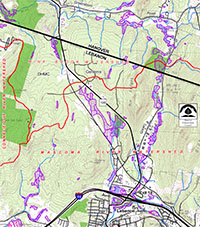2011 marked our 50th year! Since 1961, we have spoken up for community conservation, responsible land management, and the timeless pleasure of getting outdoors close to home.
On Sunday, September 25, 100 friends and supporters joined us at the summit of Balch Hill in Hanover, where it all began. We were treated to sunny skies, scudding clouds, and the presence of many of those who had helped us protect this well-loved place so many years ago. photo by Lisa Densmore
President Nancy Collier welcomed the group and recalled our past and present. She recognized our first president, Bob Norman, who was presented with a cherry Shaker-style tray. Bob offered recollections of our first years as the Hanover Conservation Council.
Executive Director Adair Mulligan celebrated the Conservancy’s valuable partnership with the Town of Hanover and the Upper Valley Land Trust, and presented an inscribed Aldo Leopold bench to Vicki Smith, Senior Planner for the Town, and Jeanie McIntyre, President of UVLT. The benches and Shaker tray were made by Conservancy member and craftsman Jim Duffus. (More about Aldo Leopold… plans for building an Aldo Leopold bench)
Vice President Kristine McDevitt, assisted by an able young visitor, distributed blueberry bushes from E.C. Brown’s Nursery and kites from College Supplies to five lucky winners of our “trail” prize raffle. Children engaged in a scavenger hunt, and Hanover High School student Jaden Gladstone entertained the group with his Appalachian music, on fiddle and banjo.
Refreshments were enjoyed by all, and included a taste of fall from Riverview Farm in Plainfield, NH – rosy Empire apples and fresh-pressed cider, along with home-baked goodies from members of the Balch Hill Stewardship Committee.





